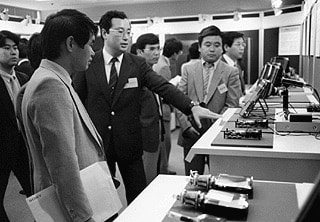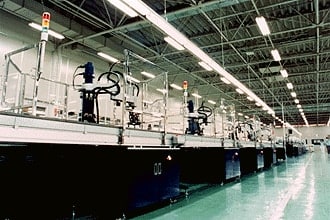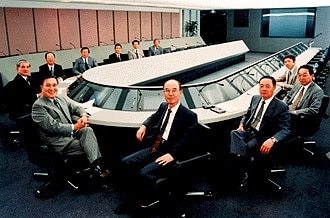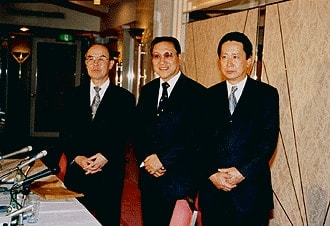 The new management team in September 1982
The new management team in September 1982 In August 1982, Kazuo Iwama, Sony's president since 1976, passed away. A meeting of the board of directors was held in September of that year and Norio Ohga was appointed President. Ohga had a proven track record as President of CBS/Sony Records. In just ten years since its establishment, he led the company to the top position in the Japanese record industry.
At a quickly arranged gathering of journalists at the Palace Hotel in Tokyo, Ohga outlined his aspirations as the new president of Sony. He briefly acknowledged the difficulties he was facing, having been appointed president of Sony amid a severe business climate. The world economy remained in a protracted slump, and Sony was battling to develop its mainstay business, the home-use VCR. He then explained that his most important role as president was to enhance the brand image of Sony established by his predecessors. This emphasis on further developing the Sony brand image was to become the cornerstone of Ohga's management policy.
Ohga, a baritone who had graduated from the Tokyo National University of Fine Arts and Music, illustrated his approach to management in musical terms. "I think that managing a company is like conducting an orchestra. Just as a conductor must work to bring out the best in the members of his orchestra, a company president must draw on the talents of the people in his organization."
Ohga remained in charge of the CD business, for which he had been at the forefront in establishing standards. Picking up where Iwama had left off, Ohga began to push for the mass production of the CCD. In addition, Ohga pressed ahead with the development of a new management strategy and organizational structure. He had always thought about the future of Sony, which at that time had grown into a large company boasting sales of 1 trillion yen. His goal was to make Sony a truly top-ranking company.
Ohga told the employees and management of Sony, "We can no longer just depend on VCR products like the Betamax. We must develop new businesses." In 1983, the year after he was named president, Ohga set forth on his new business strategy of consolidation and diversification. This strategy entailed strengthening such existing products as Betamax, strengthening the semiconductor business, establishing Sony as a top-ranking tape manufacturer and developing new businesses in areas like microcomputers and office automation.
During the 1970s, Sony had been able to grow and profit as a manufacturer of small consumer electronic goods. Compared to other companies, its investment was modest in areas outside of consumer products, such as semiconductors and computers.
Ohga established a clear strategy regarding semiconductors for the first time. Sony decided to carry out external sales and original equipment manufacturing (OEM) of semiconductors along with other component parts. Until then, the notion of selling key Sony components to other manufacturers had been taboo. As miniaturization of semiconductors advanced in the 1970s, the production of such parts required large capital investment. Sony realized, however, that it had special technology in the field of miniaturization and had been using it in the manufacture of consumer products. This led the company to produce small components and parts for external customers as well. Ohga's decision to promote the OEM business was to change the course of Sony's history.
The company was aiming to derive revenue equally from consumer electronics products and sales from its other businesses by 1990. "Other businesses," referred to professional products for industrial and commercial use which had rapidly taken off in the latter half of the 1970s. It also referred to the component parts which Sony had just started selling on an OEM basis.
Sony set specific targets: consumer electronics products would account for 50% of sales, professional products for 30%, and the component business for 20%. Through the full-scale commencement of external and OEM sales, the component business was set to become one of Sony's leading businesses.
A marathon, thirteen and a half hour shareholders' meeting held in January 1984 accelerated the company's creation of new pillars for business diversification. At this meeting, a fall in both consolidated and non-consolidated earnings was reported for the first time ever along with the weakened position of Sony's mainstay Betamax product.
 Sony's JumboTron attracts attention at the 1985 World
Sony's JumboTron attracts attention at the 1985 World Ohga was instrumental in making changes to Sony's corporate structure. As he watched Sony grow, Ohga believed that all Sony managers should follow strict budgetary controls. Until that time, Sony had not rigorously enforced budgetary controls, but had grown thanks to the determination of founders Ibuka and Morita who boasted unique management styles and great technological ideas. However, as times changed, Sony could no longer follow such a management approach if it was to truly become a top-ranking company.
Ohga said, "When setting out on a voyage, it is necessary to have a chart to show the way. In business, a budget is a company's chart. Before setting out on its voyage, the company sets its goals and estimates both costs and benefits."
"In Sony's case, failure to establish a proper budget could mean that sales stagnate at 1 trillion yen," added Ohga, who decided to split the company into a number of smaller organizations. Each organization would prepare its own budget. The prevailing attitude at the time emphasized finished products and technology. Despite this, each chart would have to include targets relating to such areas as manufacturing and marketing, which until then had received only scant attention.
In May 1983, a business group system was introduced. This system was conceived by Ohga and drawn up by Ken Iwaki, then head of Corporate Planning. Under the system, Sony would create a number of "mini companies," or business groups, that would conduct operations in a defined business area. Sony would then give the head of that group the responsibility and authority for all its operations, from manufacturing to sales. Product marketing, which had been considered solely the responsibility of the centralized sales and marketing departments, now became the group's responsibility as well. The new business groups were also expected to maximize profits within the limitations of their responsibilities, and to maintain their own P&L statements and balance sheets.
Sony was not the first Japanese company to introduce such a business group system. But Sony's system was unique in that the groups were responsible for both domestic and overseas sales. Such a consolidated approach had never been tried before. Sony's product divisions had previously taken the view that if they produced and delivered the required quantities on schedule, then they were meeting their responsibilities.
Aiming to heighten awareness among the new business groups, Ohga said, "Even if Sony makes a profit by manufacturing and shipping products to sales companies, if these companies cannot sell our products and subsequently become unprofitable, it means that Sony's efforts are useless. We must ensure that our production process is efficient, while remaining conscious of the final destination of our products. For this reason, we must reach the right balance between manufacturing and sales." Additionally, Ohga was of the opinion that a group head must make every effort to maximize the consolidated net sales of his group, keeping in touch with both Japanese and international market trends.
As part of his restructuring plan, Ohga changed the role of Sony's two deputy presidents. Masaaki Morita, who was head of the consumer products business, was put in charge of overseeing global production and marketing activities. Masahiko Morizono, who was head of the industrial products business, was given the role of overseeing development, technology, and product planning throughout the company.
Sony had often been referred to as a developer of new products as a result of its strong emphasis on improving technology and product planning. However, Sony now made a fresh start, aiming to become a truly top-ranking company that maintained an appropriate balance between sales and production.
Ohga wanted Sony to become such a company in every aspect of its business, including product development, planning, design, manufacturing, sales and customer service. In October 1982, immediately following his appointment as president, he established a Production Technology Group that united the production technology and device groups into one.
 Sony's first component parts exhibition for OEM
Sony's first component parts exhibition for OEM In 1983, Sony decided to begin full-scale component sales on an OEM basis. As Sony was relatively new to this area, Ohga and his team had to start by determining what approach to take and which markets to target.
Initially the plan was to focus on semiconductor operations. However, it was decided that Sony should instead begin by selling well-established products. Management was confident in Sony's expertise in the areas of AV, computers, mechatronics, magnetic recording devices and televisions. At the Japan Electronics Show in October 1983, Sony exhibited ICs, precision motors and CRTs to advertise its components sales business. The success of OEM 3.5-inch micro floppy disk drives (MFDD) sold to computer makers reinforced Sony decision to enter the OEM market.
To undertake full-scale marketing activities, a sales force was necessary. In July 1984, the Components Marketing Group was created under director Junichi Kodera. The component sales team faced many hardships both inside and outside Sony. They had to start not just from zero, but from well behind the start line. According to some, "Selling components [was] like delivering technical know-how to competitors on a silver platter." The engineers appointed to the development team were equally unenthusiastic. Some even went as far as to complain that they felt no passion for making products which would not bear the Sony name.
 Sony's automated production and inspection lines
Sony's automated production and inspection lines Sony's component team got off to a rough start, but sales gradually began to pick up. The team's successes led to a drive within Sony to enhance production technology. Such an improvement in production was necessary due to the extreme demands of the OEM business. A large degree of flexibility was required to meet demands for quality, pricing, delivery dates, and quantities. To be profitable under this situation, it was necessary to achieve efficient production. Unlike finished products, the incorporation of sophisticated technology into components did not guarantee high volume sales at high prices.
Under the motto, "Innovation 86," the entire Sony Group introduced production innovation programs. Sony Kohda achieved the most outstanding results by doubling its output in three years. This was through the introduction of fully automated systems for its 8mm mechanical deck lines. The fully automated production line for 3.5-inch MFDDs at Sony Asco was instrumental in supporting the 3.5-inch MFDD OEM business. Production capacity and cost-consciousness increased at Sony thanks to its OEM businesses.
In 1986, Yoshiyuki Kaneda, serving as director of both the Production Technology Group and Components Group, was instrumental in implementing innovations in production systems and in promoting component sales to the OEM market. Kaneda introduced specific measures to improve production design by reducing the number of parts used. These measures included the development and improvement of industrial engineering (IE) and the employment of automation, to maximize production capacity through the best combination of automation and manual assembly.
Meanwhile, Kaneda concentrated on establishing optical pickups for CDs and magnetic devices, such as 8mm VCR heads, as the two main pillars of the component parts business. Sony jumpstarted the CD business worldwide by promoting the CD format and providing optical pickups and other key devices for the system to other manufacturers.
Underlying these efforts was the decision by Kaneda's team to realize overseas production of key devices from an early stage. A principal factor prompting this decision was the signing of the Plaza Accord in September 1985. Sony was in the midst of implementing "Innovation 86" at this time. Kaneda was sure that the further appreciation of the yen would force Japanese manufacturers to transfer their production facilities for CD players to Asia, and hence, demand for parts and components for CD players would grow in this market. In 1987, Sony established Sony Precision Engineering Center (Singapore) Pte. Ltd. (SPEC) as an automated facility to manufacture optical pickups, heads and drums for VCRs.
In line with Sony's principle to manufacture where the market is, Kaneda thought that by setting up a component parts factory, he would generate further market demand. Since its establishment in 1987, SPEC has grown in importance to become Sony's center for production technology in Asia.
 The new company system under President Ohga.
The new company system under President Ohga. Between 1992 and 1994, consolidated sales for the Sony Group quadrupled to approximately 4 trillion yen with Ohga as president. This growth was maintained by Sony's continuous efforts to develop unique products, its entry into the music and film businesses, and its drive to conduct R&D and production abroad. The organizational structure that made this possible was the business group system.
As they entered the 1990s, Ohga and Morita began to believe that the business group structure was suitable only for the high-growth 1980s. The business groups had held each business together tightly as a unit and had served as the driving force to promote products. In fact, these units successfully launched many new groundbreaking products like the CD, MD, 3.5-inch MFD and lithium-ion batteries.
Nonetheless, Japan's recession and the surging yen had forced Sony into decline. At the end of November 1993, Morita, then CEO and Chairman, suddenly fell ill. This created a further crisis for Sony, and in order to emerge from this situation, Ohga imposed a drastic reorganization.
Ohga's intention was not to do away with the business groups, but to further develop the organizational structure of Sony into something that was more advanced and able to meet Sony's needs. That is how the "company within a company" system came about. In April 1994, the nineteen business groups were reorganized into eight divisional companies, each responsible for all operations from production to sales. Presidents, who were given more authority than the directors of the previous business groups, oversaw these companies. The aim of this reorganization was to create a more self-contained and efficient operation.
The eight divisional presidents were entrusted with the authority to make decisions on investments up to a certain value and on personnel issues for employees under the rank of divisional director. Furthermore, their responsibility for each company's profit and loss statement, balance sheet, and cash flow management were increased. Ohga's aim was to have these divisional presidents fulfill a function similar to that of a company's CEO with full accountability to shareholders. In addition, he hoped that the divisional presidents would draw on their own entrepreneurial spirit to establish self-contained organizations.
When asked what his own responsibilities to these newly established companies would be, Ohga replied, "First of all, I would like for the divisional presidents to run their companies as if they were reporting to shareholders once a year at a shareholders' meeting. My role will be to review their strategies, examine any points I feel should be questioned and provide advice when and where necessary."
A memorandum entitled "The Introduction of the Company Within a Company System" was circulated in Ohga's name to explain the five primary goals of the new system. The first was to further enhance core businesses while developing new ones; the second was to introduce an organizational structure whereby sales and production would work closely together and respond quickly to market changes; the third was to simplify the structure in order to clarify responsibilities and transfer authority so that responses to external changes were quick; the fourth was to reduce the levels of hierarchy in the organization; and the fifth goal was to encourage entrepreneurial spirit in order to foster a dynamic management base for the 21st century.
In the introduction to his memorandum, Ohga wrote that the purpose of the reorganization was to allow for a breath of fresh air to sweep throughout the company and create a new feeling of dynamism. Indeed the new company system had simplified Sony's organizational structure in a drastic way. Traditionally, the decision-making process had up to six layers of management below the Policy Board level. This was changed to a maximum of four layers. The change was an effort to reduce the layers of management between an entry-level employee and top management. As a result, the number of divisions was reduced from more than 580 to approximately 450.
While implementing this internal decentralization, Ohga and top management continued to emphasize that Sony Corporation was one company. Day to day operations were of course carried out by the eight divisional companies independently, but top corporate management made important decisions affecting Sony as a whole.
 The March 1995 announcment of Nobuyuki Idei as
The March 1995 announcment of Nobuyuki Idei as In November 1994, founder and honorary chairman Ibuka became founder and chief advisor. Morita, who was recuperating from his illness, was appointed founder and honorary chairman at that time. These changes meant that the two founders of Sony had distanced themselves from the direct management of the company.
The company system had gotten off to a smooth start and was on track for success. Meanwhile, Ohga had been assuming the role of chairman in Morita's place. Reflecting on his twelve years as president, Ohga reached the conclusion that it was time for him to hand over the helm to the next generation of management. He felt that this was his last and most important mission as president. In fact, handing over to a new generation was an additional factor behind the introduction of the company system and encouraging the divisional presidents to take initiative in their fields. Ohga thought deeply and mulled over the issue for quite some time. By the end of 1994, he had finally made up his mind.
1995 arrived, meaning that only one year remained before Sony's 50th anniversary. On March 22, following an extraordinary board of directors meeting, Sony announced its new president and top management. Ohga chose Nobuyuki Idei as his successor. This announcement came as a great surprise to the business community. Idei had just become managing director in charge of advertising, public relations and product design the previous year.
Along with Idei's appointment as president, Ohga became chairman, and Tsunao Hashimoto became vice chairman. Ohga's plan was for the company to be led not by a single charismatic figure but by a team of executives -- a Chairman and CEO, a Vice Chairman, a President and COO, several chief officers and divisional presidents.
Ohga's selection of Idei represented the direction in which Ohga was trying to lead Sony. "Sony needs someone who is not necessarily an engineer, but appreciates technology; someone who recognizes the latest technological developments and has the foresight to see future technology trends; someone who understands the software business; and someone who has a global perspective. All these indicators led to Idei-san," explained Ohga. Those inside and outside Sony who had been surprised by Idei's selection finally understood Ohga's reasoning upon hearing these words. Idei had joined Sony thirty-five years before, aspiring to work for a company that he thought would succeed in the European market. During the 1960s and 1970s, Idei spent close to a decade in Europe. He then moved on to overseeing audio, computer and VCR business operations, even though his background was not in the engineering field. In the 1990s, as a director in charge of advertising, product design and public relations, Idei concentrated his efforts on promoting the Sony brand image.
After the press conference of March 22, one of Idei's first tasks was to address the new Sony recruits joining on April 3. At this ceremony, Idei shook hands with each of the 270 new employees. His hand went numb toward the end. In his speech, Idei said that when he was shaking hands with each employee and giving a word of encouragement, it felt as if he was encouraging himself as well. Sony's 50th anniversary in 1996 would be a new start for Sony -- a time of rebirth. He urged the new employees not to think of their first day as just the beginning of a career with a company which had consolidated sales of 4 trillion yen, but as the start of a new life with a company that was being reborn.